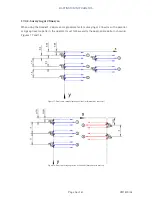
BARTINGTON INSTRUMENTS
Page 22 of 61 OM1800/26
The sampling frequency can be changed in the parameters menu, as in NMEA Mode this is not
based upon Grid size or walking speed.
The ranges and resolution provided in NMEA Mode are the same as in Grid Mode: see
Gradiometer Range and Resolution
.
It is still necessary to undergo the setup procedure in a suitably quiet area before use to
remove offset, scaling, and directional errors. To scan the area to assess its suitability, set the
gradiometer to
Run
. See
Checking and Adjusting the Sensors
for more details.
Note:
When using MLGrad601 (Geomar Software) to collect the NMEA data, press the
Run
button on the data logger before logging is begun in the software.
12.1. Set Parameters Menu: NMEA Mode
Before use in NMEA Mode the data logger needs to be set up with the correct survey and data
output parameters. Select these based on your survey requirements, as well as the specification
of your GPS and/or data logging device.
The following options can be set via the
Set parameters
menu in NMEA Mode.
Option
Default
Function
Sensors
: 2
Select the number of sensors connected: 1 or 2.
Range
: 100nT
Select the full scale range of the sensors: 100nT or
1000nT.
Sample at
: 1Hz
The measuring frequency of the sensors: 0-10Hz in
1Hz increments.
Baud rate
: 9600
The data transmission rate per second through the
RS232: 9600 bits per second.
Audio
: On
Select whether or not the instrument sounds an audible
alarm: Off or On.
Threshold
: 1nT
The measurement threshold at which the alarm
sounds in nT: increments in units, tens and hundreds
and thousands of nT. When the field deviates by the
level selected, the
ALARM
message will be shown in
the display for the appropriate sensor, and the audio
output rate will start to increase. The audio tone varies
from the value set to about ten times this value.
Volume
: High
The volume of the audible alarm: High or Low.
Reject
: 50Hz
Select to remove 50 or 60Hz mains interference.
Save
Save the parameter settings shown in the display.






























